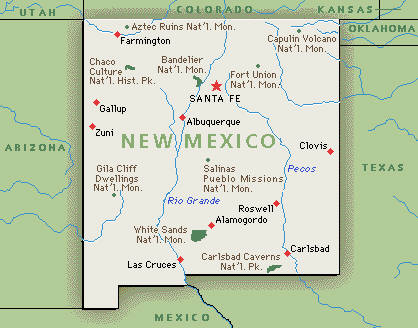
RPCV David Call teaches using the dual-language model
Are 2 Better Than One?
By Gabriela C. Guzman
Journal Staff Writer
It was a no-brainer for Wendy Payne.
Last summer, when Payne registered her youngest daughter, Rebecca, for kindergarten at Agua Fria Elementary School, a teacher approached her about participating in the school's newest program.
Under the program, the school's youngest learners are taught in both English and Spanish. Within the class, there's a mixture of Spanish and English speakers, along with those who speak both.
As this first group of students grows older, another class will be added, according to the program's architects at Agua Fria.
If the results experienced at other schools across the country using this model— commonly referred to as dual language— bear out at Agua Fria, by the time Rebecca graduates from sixth grade, she will be reading, writing and speaking in both languages.
She would then become the only bilingual person in her family.
Living in Santa Fe, it makes sense to speak Spanish, Rebecca's mother said.
"That's all they speak here. I figure she can teach me, too," Payne said, smiling broadly as she looked down at Rebecca standing in front of the school recently.
The benefits aren't strictly language related.
Both native Spanish and English speakers experience long-term educational success, according to research, which also reveals that students who participate in this model are less likely to drop out of school later in life and more likely to go to college.
Self-esteem is boasted as well, because students act as teachers for each other— Spanish speakers help English speakers and vice versa.
About two years ago, the school's bilingual teachers gathered to add more uniformity to their bilingual teaching models. Soon, the conversation grew into a more philosophical debate about ways of better educating all students, namely closing the district's wide achievement gap between Hispanic and white children.
"We had a desire to figure out what we wanted to do and where we were going and finding out what were the most effective programs," said David Call, the kindergarten teacher at Agua Fria using the dual-language model.
Positive results
Many of those familiar with dual-language programs say the research shows incredible results.
According to a report analyzing results of 210,054 Spanish-speaking students enrolled in various bilingual programs in five urban and rural areas across the country from 1996 to 2001, the dual-language model produced the highest results.
It was the only bilingual model in which students reached the 50th percentile in all subjects by the time they ended high school, according to the report done by Virginia Collier and Wayne Thomas of George Mason University. The fewest dropouts came from this group.
But incorporating the dual language model into a school requires a lot more than just interest.
"Any school considering this program, I just really recommend they do a lot of homework," said Carlos Pagán, a dual-language consultant with the Northern New Mexico Network.
For five years, Pagán was the principal at a dual-language school in northern California. Pagán now lives in Rio Rancho with his wife, a native New Mexican, and their son. He's also writing his dissertation at Columbia University on dual language.
Teachers have to be educated in the model to implement it correctly and receiving periodic training in various teaching models is a must, dual-language experts say.
Dual language began as a separate program in Pagán's school, now called the Napa Valley Language Academy.
"We thought not all the parents would want it," Pagán said, but he turned out to be wrong.
With its high academic standards and committed staff and parents, it eventually became an all-dual language school, Pagán said.
After a few years, teachers and students began making presentations around the community. Kiwanis Club members and parents groups reacted strongly after seeing blond-haired, blue-eyed fifth-graders making presentations in near-perfect Spanish.
"The whole community got behind the school," Pagán said.
Now there is a lottery system for the school's 100 annual student slots.
Nationally, school district are latching onto the dual-language model.
By 2000, there were 278 dual language schools in the United States, up from 39 in 1990, according to the Washington, D.C.-based Center for Applied Linguistics.
As with the majority of dual language schools and programs, students can only enter at the kindergarten level, thus eliminating its use for older students.
"One model does not fit all," said Catherine Collins, director of the Santa Fe Public Schools bilingual program.
Other models
Even with its many documented successes, there is still a need for other bilingual education models in the district, Collins said.
Collins describes the dual-language model as needing a lot more study. It would seem near impossible to develop it at many more district schools because of a lack of resources, mainly certified bilingual teachers.
A lack of trained teachers and administrative support is what weakened the dual-language model at Nava Elementary School, say those familiar with the school.
The district was recently cited by the federal government for not equally educating its growing number of Spanish-speaking students. The absence of sufficient bilingual teachers was noted as a major finding in the federal government's report.
Collins also questioned if schools would be able to find and keep highly skilled, Spanish-speaking teachers to teach subjects, such as social studies and math, in the upper grades.
Call, the teacher at Agua Fria, acknowledges that the success at his school is dependent on teachers committing to stay there, at least while the program grows.
"We all recognize it can be a challenge. We control that to the extent that we can," Call said, noting that the program was teacher driven and has tremendous support from the school's administration.
Michael Rodriguez, the school's assistant principal, enrolled his daughter in Call's class.
"We are all here because we want to be," Call said.
Gladys Herrera-Gurulé, state director of bilingual education, agreed with Collins that dual language could never be the only model offered in public schools. But when a school district approaches the state bilingual education department about best practices, Herrera-Gurulé directs them towards dual language.
"We recommend if they really want results and they take into account the research, this is the best model," she said.
Teachers from Mexico and Spain could fill in the gaps schools might experience in the upper grades, she said.
With recent changes in the laws dictating bilingual education, schools can also receive funds for native English-speaking students, Herrera-Gurulé said.
Previously, schools could only receive additional funds for Spanish-speaking students.
With the change in funding, she anticipates New Mexico's dual-language programs will continue to grow.
In 1997, the state began with 228 students in dual-language programs. Last year, the number reached 8,550 students, while this year the number jumped to about 11,000, according to state Education Department statistics.
Through private and group meetings, Agua Fria teachers convinced the 20 families in the program to commit their children to it.
Aside from her daughter becoming bilingual, Luz Molinar said she remembers few of the benefits explained to her before enrolling her daughter in Call's class.
Mainly though, she heard from other mothers that Call was a good teacher, with students leaving his kindergarten class reading and writing.
Molinar speaks only Spanish but she added that her daughter is quickly picking up English.
"It is important to learn both," said Molinar, who works in the school's cafeteria.
Who can teach?
Others outside the district have questioned the ability of a non-native Spanish speaker to teach in any bilingual model.
During a recent bilingual teachers conference in Albuquerque, Call said a Hispanic bilingual teacher argued against allowing non-native Spanish speakers to teach in a bilingual classroom.
Needless to say, Call did not agree with him.
"I've never once felt uncomfortable teaching in Spanish. If I don't know a word, I'll be the first to admit it," Call said, who became fluent in Spanish after completing a two-years assignment in the Peace Corps in South America.
Some experts in the dual-language model argue that native speakers should teach in their home language, but others say it's not necessary.
Considering the wide variety of Spanish spoken among native speakers in the United States, Latin America and Spain, students in dual-language programs will hear a number of dialects, said Teresa Márquez-López, the director of the Two-Way Immersion Biliteracy Specialist Institute, based at the University of California, Riverside.
The institute works with six school districts in southern California that have adopted the dual-language model.
A non-native speaker can also become a model for the students, said Márquez-López.
"The kids will say 'Look it, he speaks Spanish,' '' she said.
Get Copyright Clearance Copyright 2005 Albuquerque Journal










